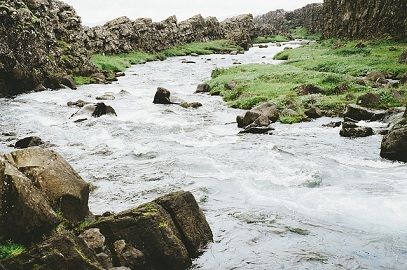 Rivers are described as the large natural water body, which flows towards the sea or another river. It is one of the major sources of water supply to the living beings. In India, the rivers are broadly classified as Himalayan Rivers and Peninsular Rivers. Himalayan rivers are the watercourses that arise from Himalayan ranges and are perennial in nature. On the contrary, Peninsular rivers are the ones that originate from the Western Ghats and are non-perennial.
Rivers are described as the large natural water body, which flows towards the sea or another river. It is one of the major sources of water supply to the living beings. In India, the rivers are broadly classified as Himalayan Rivers and Peninsular Rivers. Himalayan rivers are the watercourses that arise from Himalayan ranges and are perennial in nature. On the contrary, Peninsular rivers are the ones that originate from the Western Ghats and are non-perennial.
The catchment area of Himalayan rivers is very fertile, whereas Peninsular river basin is not much fertile. The article excerpt may help you in understanding the difference between Himalayan and Peninsular rivers.
Content: Himalayan Rivers Vs Peninsular Rivers
Comparison Chart
| Basis for Comparison | Himalayan Rivers | Peninsular Rivers |
|---|---|---|
| Meaning | Himalayan Rivers are the rivers that originate from Himalayan ranges and flows throughout the year. | Peninsular Rivers include those rivers that arises from Western Ghats and receive water only during a particular period. |
| Nature | Perennial | Non-perennial |
| Form | Delta | Some rivers form delta while others form Estuary |
| Shape | Meandering | Straight |
| Rocks | Bed rocks are soft, sedimentary and easily erodible | Bed rocks are hard, resistant and not easily erodible |
| Fed by | Snow and rain | Rain |
| Drainage basin | Large | Small |
| Irrigate | Northern Plains | Deccan Plateau |
| Valley | V-shaped valley is formed | U-shaped valley is formed |
Definition of Himalayan Rivers
Himalayan Rivers are described as the rivers that arise from Himalayan mountain ranges, which receive water from both rain and melted snow from glaciers. The Indus, the Ganga and the Brahmaputra are the three important Himalayan Rivers. These help in irrigation and cultivation of dry areas and farms, throughout the year.
Himalayan Rivers are characterised with long courses from their point of origin to the sea. They carry a large quantity of sand and silt, due to their exhaustive erosional activity in the upper courses. Further, they form meander and oxbow lakes in the middle and lower courses.
Himalayan rivers form big deltas. Sundarban delta is one of the biggest delta formed by the Ganga and Brahmaputra.
Definition of Peninsular Rivers
Peninsular Rivers are the seasonal rivers as their flow primarily relies on the rainfall. These rivers experience a reduction in the flow of water, even if they are long, during the dry season. They are characterised with short and shallow courses.
Most of the peninsular rivers arise from the Western Ghats, flows towards the east and drain into the Bay of Bengal. It includes rivers like the Mahanadi, the Godavari, the Krishna and the Cauveri, etc. that make deltas. However, the Narmada and the Tapi are the two rivers whose point of origin is the central highlands, and they flow towards the west, and makes estuaries. Estuaries are nothing but small deltas.
Key Differences Between Himalayan and Peninsular Rivers
The points given below clarifies the difference between Himalayan and Peninsular rivers:
- Himalayan Rivers are the water bodies that emanate from the north of Himalayan mountain ranges. On the other extreme, Peninsular Rivers include those watercourses that arise from, Western Ghats or Central Highlands.
- The Himalayan rivers are perennial, i.e. they have water all around the year. As against, Peninsular rivers are seasonal, in the sense that they have water during a particular period only.
- Big deltas are formed by Himalayan Rivers. On the other extreme, some peninsular rivers like the Mahanadi, the Godavari, the Krishna and the Cauveri form deltas, while the Narmada and the Tapi form estuaries.
- While Himalayan rivers form meanders, there is an absence of meanders in case of Peninsular rivers.
- The bedrocks of Himalayan rivers are soft, sedimentary and easily erodible. Conversely, bedrocks of Peninsular rivers are hard, resistant and not easily erodible.
- Himalayan rivers get water from snow and rain, whereas Peninsular rivers are fed by rain only.
- The drainage basin of Himalayan rivers is comparatively larger than the Peninsular rivers.
- Himalayan rivers water helps in the irrigation of Northern Plains. In contrast, Peninsular rivers irrigate Deccan Plateau.
- Himalayan rivers form a V-shaped valley, while Peninsular watercourses form valley having a U-shape
Conclusion
The channel and valley length of the Himalayan River system is larger in comparison to the Peninsular River system. While in case of Himalayan Rivers, water is added by the underground sources also, but in case of Peninsular rivers due to hard lithology, no underground water is added to the river.






JINAY MEHTA says
THANK YOU SO MUCH
THIS REALLY HELPED ME
lakshay says
Thank you mam it was very helpful
Abisha says
Good job Ma’am…
Thank u so much…
James says
Thank u maam
It really helped me
Mahesh says
Really Good. Was very Helpful.
P.Pooja says
Thanks so much
Muskan Bajaj says
Thanks
Sourav says
Good
Anshu says
Thankyou so much. It was very helpful 🥰🥰🥰🥰😍😍
Rohit YT says
Thank you so much mam
Ok says
Thanks ❤😍
Llb says
thanks